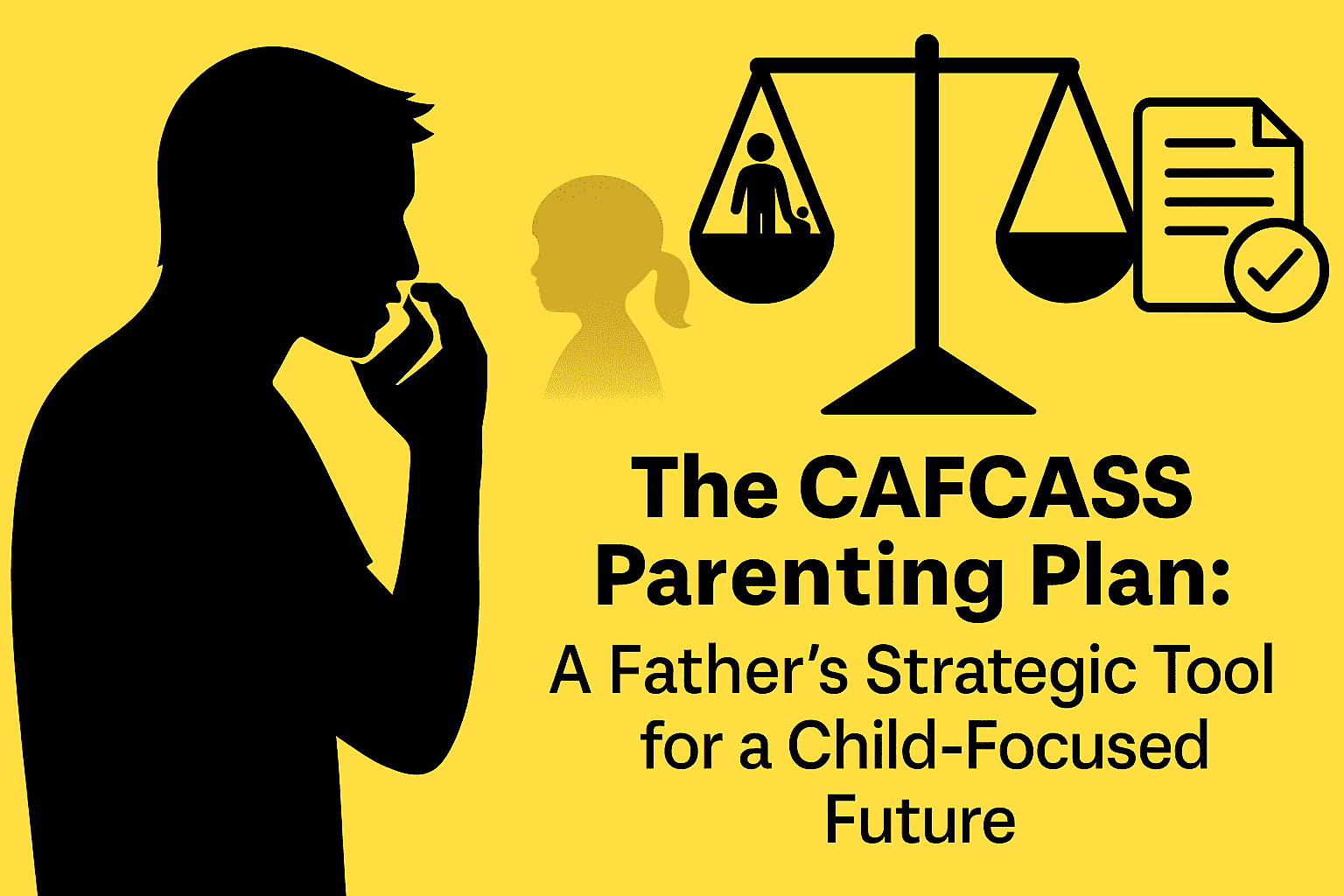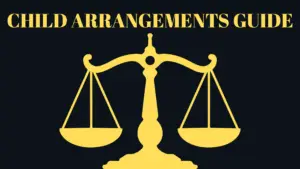Last Updated: Saturday, 6 September 2025
After a separation, one of the most difficult and emotionally charged tasks is trying to agree on arrangements for your children. Conversations can quickly descend into arguments, leaving you feeling frustrated, powerless, and worried about your child’s future. I have been subjected to significant emotional discomfort when fathers describe this breakdown in communication, where the focus shifts from the children’s needs to the adult conflict.
In these situations, a structured tool can be invaluable. The CAFCASS Parenting Plan is a document designed to help parents move away from conflict and towards a clear, child-focused agreement. As a consultant who has used these plans for years to help families, I know that a well-thought-out Parenting Plan can be the key to avoiding a lengthy court battle. This guide will explain what a Parenting Plan is, what it covers, and how you can use it strategically to build a stable and positive future for your children.
Key Takeaways
- A Parenting Plan is a written agreement about your children. It is a document that helps you and your ex-partner think about and agree on all the practical aspects of co-parenting after a separation.
- It is not legally binding on its own. A Parenting Plan is a voluntary agreement. However, it can be attached to a consent order and approved by a judge, which then makes its terms legally enforceable.
- The plan is entirely child-focused. It forces you to consider every aspect of your child’s life, from their health and education to their time with each parent, through the lens of the Welfare Checklist.
- It can be a powerful tool for avoiding court. Presenting a thoughtful, detailed Parenting Plan to your ex-partner is a constructive way to start negotiations and show you are a reasonable and child-focused father.
Want expert help drafting your Parenting Plan? WhatsApp us today and let’s get it right.
Jump To
What to Include in Your Parenting Plan
The official CAFCASS Parenting Plan is a comprehensive document that prompts you to think about all the details of your child’s life. It is more than just a calendar of dates; it is a holistic plan for your future as co-parents. As a former CAFCASS officer, I can tell you that a judge is always impressed by parents who have taken the time to think through these issues in detail.
Key sections of the plan include:
- Living Arrangements: Setting out the day-to-day routine, including term-time and school holidays.
- Health: How you will make joint decisions about your child’s medical care.
- Education: How you will both support your child’s schooling and attend parents’ evenings.
- Communication: Agreeing on how and when you will communicate with each other about the children.
- Financial Support: Clarifying child maintenance arrangements.
Here is a practical example of the kind of clear and child-focused wording you should use in your plan.
A Snippet From a Well-Written Parenting Plan
Section: Communication Between Parents
- We agree to communicate with each other about the children’s welfare primarily via the ‘Our Family Wizard’ app to ensure a clear and respectful record.
- We will not use the children to pass messages between us or discuss adult issues in their presence.
- We will endeavour to respond to any message regarding the children’s health or urgent matters within 4 hours.
- We will hold a brief telephone call once a month, on the first Sunday of each month at 7 pm, to discuss any upcoming issues, such as school holidays or appointments.
Struggling to put your plan into words? Message us now — we’ll guide you step by step.
A Deep Dive: The Principles of Co-Parenting
The entire concept of a Parenting Plan is built on the foundation of successful co-parenting. This is a term the family court uses frequently, and it is what they expect from separated parents.
Official Definition: Co-parenting is a parenting situation where the parents are not in a romantic relationship but continue to jointly participate in their child’s upbringing. The core principle is a shared commitment to the child’s welfare, requiring communication and cooperation between the parents.
Breakdown of Components:
Co-parenting sounds simple on paper, but in reality it has a few moving parts. Breaking these down helps you see what the court expects and where dads often slip up.
Child-Focused Communication
What This Means For You: Your communication with your ex-partner must be respectful and focused solely on the needs of your child. It is about logistics and welfare, not about your past relationship or adult disputes.
Separating Parental Issues from Partner Issues
What This Means For You: This is the most difficult but most important skill. You must be able to separate your feelings about your ex-partner from your role as a co-parent. The court expects you to work with her as a parental partner, even if you dislike her as a person.
Respecting Each Other’s Role
What This Means For You: Successful co-parenting involves acknowledging and supporting the child’s relationship with their other parent. This means speaking positively about your ex in front of the child and not undermining her parenting decisions (unless there is a genuine safety concern).
Consistency and Routine for the Child
What This Means For You: Children thrive on routine. A key goal of co-parenting is to provide a consistent experience for the child across both households, with similar rules, bedtimes, and expectations.
A Real Life Scenario: Mark and Sarah have separated and are in conflict. Mark wants to show the court he can co-parent effectively. Before the first hearing (FHDRA), he sends Sarah a draft Parenting Plan. The plan is detailed and suggests using a communication app. It proposes a clear schedule for holidays and handovers. At the hearing, the judge is impressed that Mark has taken this constructive step. This single action demonstrates his child-focused approach and willingness to co-parent, setting a positive tone for the rest of the case.
Common Pitfalls:
Even with the best intentions, some fathers approach a Parenting Plan the wrong way. These are the traps that can turn a constructive tool into fresh conflict.
- Using the plan as a weapon: Why this is a mistake: A Parenting Plan should be a tool for agreement, not a list of demands. Sending a plan that is entirely one-sided will only increase conflict.
- Focusing only on the calendar: Why this is a mistake: The most effective plans go beyond just dates. They show you have thought about the child’s emotional, educational, and health needs.
- Forgetting to communicate: Why this is a mistake: Co-parenting is an ongoing process. Agreeing to the plan is the first step; you must then commit to the communication and cooperation it sets out.
At a Glance: Parenting Plan vs. A Child Arrangements Order
Both documents shape your child’s future, but they work very differently. This quick comparison shows the main differences – and when each is most useful.
| Feature | Parenting Plan | Child Arrangements Order |
|---|---|---|
| Legal Status | ✅ Not legally binding on its own. It is a voluntary, good-faith agreement. | ❌ Legally binding. Breaching the order has serious consequences. |
| How It’s Made | ✅ Created by parents working together, often in mediation or with professional support. | ❌ Made by a judge after a court application and hearings. |
| Flexibility | ✅ Very flexible. You can agree to change it at any time without going back to court. | ❌ Rigid. To change the order, you must formally apply back to the court for a variation. |
| Purpose | To help parents agree and avoid court, or to present a clear proposal to the court. | To create a legally enforceable set of rules when parents cannot agree. |
| Best For | Parents who are able to communicate and are willing to work together for their child. | ❌ Parents who are in high conflict and need the authority of the court to create a stable arrangement. |
Not sure whether you need a Parenting Plan or a court order? WhatsApp us today for clear advice.
Common Mistakes Fathers Make When Creating a Plan
Judges and CAFCASS officers quickly spot a plan that’s unrealistic or self-focused. These are the mistakes that can weaken your credibility before you’ve even stepped into court.
- Making it all about you. The plan must be about your child’s needs, routine, and stability, not your “rights” or what you feel is fair to you. Every point should be justified by how it benefits the child.
- Being unrealistic. Proposing a plan that is completely unworkable for the other parent or the child (e.g., involving complex daily handovers for a young child) will be seen as unreasonable and uncooperative.
- Not thinking about the details. A good plan considers everything: who holds the passports, how you will arrange contact on birthdays and Christmas, and how you’ll handle unexpected events like illness.
- Assuming it’s a “one and done” document. A Parenting Plan should be a living document. A strategic approach is to include a clause agreeing to review it annually, or as your child gets older and their needs change.
FAQs: The CAFCASS Parenting Plan
Fathers looking to create a plan often ask these questions.
What is a CAFCASS Parenting Plan?
It is a document and template, provided by CAFCASS, designed to help separated parents agree on the practicalities of how they will care for their children. It prompts you to think through all aspects of your child’s life to create a comprehensive agreement.
Do I have to use the CAFCASS Parenting Plan?
No, you are not required to use their specific template, but it is highly recommended. It is structured around the Welfare Checklist, which is the same set of principles a judge will use to make a decision in court, so it is written in a language the court understands.
Is a Parenting Plan legally binding?
No, not on its own. It is a voluntary agreement made in good faith. However, if you and your ex-partner agree to its terms, you can ask the court to approve it and seal it as a legally binding “consent order.”
When should I create a Parenting Plan?
As soon as possible after separation. It is an excellent tool to use in mediation and can be the key to avoiding court altogether. If you do go to court, having a draft plan shows the judge you are being proactive and child-focused from day one.
Will CAFCASS write the plan for me?
No. It is a document for parents to complete together. A CAFCASS officer may refer you to the plan and encourage you to use it, especially during a Section 7 report investigation, but they will not write it for you.
What if my ex-partner refuses to engage with the Parenting Plan?
You cannot force her to. However, you should still complete the plan yourself to show the court what you are proposing. Submitting a thoughtful, detailed, and child-focused Parenting Plan with your Position Statement is a very powerful and strategic move that demonstrates your commitment.
Does the plan cover financial arrangements?
Yes, it includes a section to outline your agreements for child maintenance and other financial support, which helps to avoid future disputes.
Where can I get a copy of the CAFCASS Parenting Plan?
You can download it for free directly from the official CAFCASS website. It is available as a printable PDF or an interactive online tool.
What is the main benefit of having a Parenting Plan?
The main benefit is that it creates clarity and reduces conflict. When both parents know exactly what is expected of them, there is less room for arguments and misunderstandings, which is always in the best interests of the child.
Can a Parenting Plan help my court case?
Yes, immensely. A well-written plan shows the judge that you are organised, thoughtful, and capable of prioritising your child’s needs over adult conflict. It is one of the most persuasive pieces of evidence you can create to demonstrate your positive parenting.
Every case is different — chat with us directly on WhatsApp for advice tailored to your situation.
Insider Insight from Lach
As a former CAFCASS officer and social worker, I’ve read hundreds of statements from parents in conflict. The fathers who make the best impression are always the ones who come with a plan. A detailed Parenting Plan shows the court that you’re not just there to fight about the past; you are there to build a positive future for your child. It demonstrates that you are a parent who is capable, organised, and, most importantly, focused on what truly matters.
Meet Lach, Your Guide at Dads Consultancy
Taking the time to write a Parenting Plan can feel like a lot of work, but it is one of the most powerful and constructive steps you can take in your entire case.
Next Steps
At Dads Consultancy, we provide the specialised, expert support to help you move from conflict to co-parenting. We understand how to frame proposals in the language the court respects and can help you create a plan that serves your child’s best interests. We can help you with:
- Creating a CAFCASS Parenting Plan: We provide expert, one-to-one assistance in creating a detailed, strategic, and child-focused plan to use in negotiations or in court.
- Drafting Powerful Position Statements: We help you present your Parenting Plan to the court in a compelling and persuasive formal statement.
- Navigating Child Arrangements: We guide you through the entire court process, using your plan as the foundation of your case.
- Making Your C100 Application: We ensure your initial application is completed flawlessly and includes your positive, child-focused proposals from the outset.
Creating a Parenting Plan is a proactive step towards taking control of your situation. It shows you are a father with a clear, positive vision for your child’s future. WhatsApp us today for a strategic consultation, and let’s build that plan together.
🧠 Insider Insight: Lach, our founder, is a qualified social worker who used to write Section 7 reports for CAFCASS — the very reports that influence court outcomes. Now he helps dads respond to them. Learn more about Lach’s background.
👉 Learn more about how we can support you or book a free consultation today




